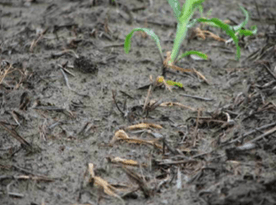Seedling Diseases in Corn
BY Dairyland Seed Agronomy Team
Since you have read the CSI (Crop Stand Investigation) article from last week’s Dairyland Seed agronomy newsletter, you may have started to walk your fields. On your walk you may have noticed a few corn plants that looked not as healthy as others. Odds are, this sickly plant is caused by one of the major seedling diseases such as Pythium, Fusarium or Rhizoctonia. Minor seedling diseases such as Penicillium, Colletotrichum and Diplodia may also impact seedlings, but not to the level as others. These diseases can have multiple species capable of infecting corn that are different in pathogenicity and environmental influences.

Pythium is a water mold that survives in the soil and plant debris and is typically only a concern in high soil moisture levels. These wet soils provide a pathway for the disease to move about and then find its way to the corn root system. Pythium is one of the first diseases to attack corn in the spring and typically is active in 50-60°F soils; however, some of the species of this disease are active under a wide range of temperatures. Pythium can infect and attack plants from seeding well into the growing season. Symptoms include darker and or slimy/greasy lesions on the root or mesocotyl which may cause them to shrivel. Pythium can also attack the seed.
Fusarium is a fungi that has a wide range of favorable temperatures and moisture conditions, but tends to attack plants that have been stressed by compaction, wet soils, and cold temperatures. Other factors, such as insect feeding, allow the disease an opening to get into the plant. Symptoms include tan to reddish brown or chestnut-colored lesions on the root or mesocotyl, which may cause shriveling of the mesocotyl. Fusarium can also cause crown or stalk rot later in the season.
Rhizoctonia is a fungi that infects corn roots from 46°-82°F but is more common in drier growing conditions. Symptoms include reddish brown or chestnut-colored lesions with sunken cankers which can be found on the root system.
Having the industry leading Seed Treatment LumiGEN® helps lessen the impact these disease might have on your corn stand.
If you have further questions about seedling diseases or other agronomic concerns, please contact your Dairyland Seed personnel.
A more in-depth examination of corn seedling diseases can be found here.

Brian Weller
Western Region
507.456.3034

Rod Moran
Western Region
507.456.3034

Dan Ritter
Central Region
219.863.0583

Branden Furseth
Northern Region
608.513.4265

Mark Gibson
Eastern Region
260.330.8968

Amanda Goffnett
Eastern Region
989.400.3793

Ryan Mueller
Eastern Region
989.400.3793
